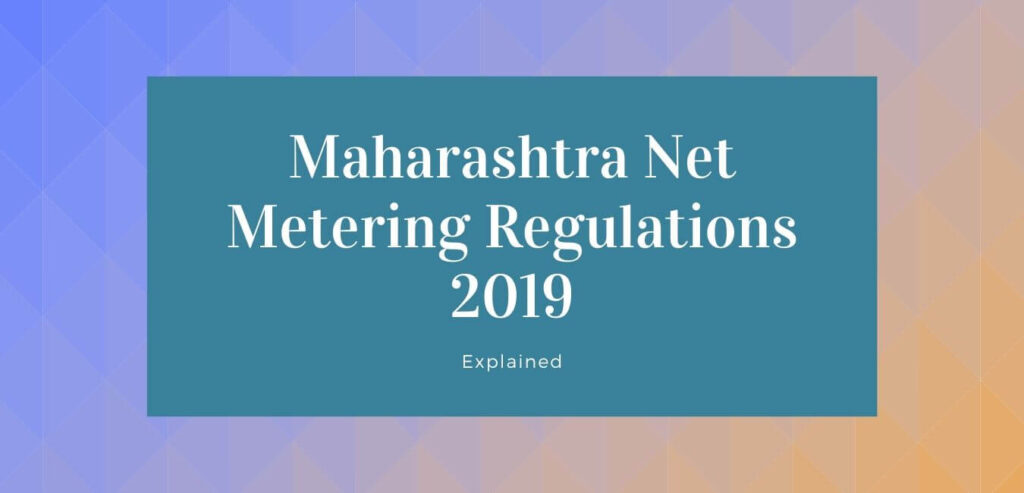On December 30th 2019, Maharashtra Electricity Regulatory Commission (MERC) issued Maharashtra Net-Metering Regulations 2019 along with other grid-interactive solar energy system regulations. The same was also published in State Gazette.
These regulations would apply to
- (a) Net Metering Arrangements;
- (b) Net Billing Arrangements;
- (c) Grid Connected Renewable Energy Generating Systems connected behind the Consumer’s meter, who have not opted either for Net Metering Arrangement or Net Billing Arrangement.
Important Definitions:
- “Eligible Consumer” means a consumer of electricity in the area of supply of the Distribution Licensee who uses or intends to use a Renewable Energy Generating System having a capacity less than 1 MW, installed on a roof-top or any other mounting structure in his premises, to meet all or part or no part of his own electricity requirement, and includes a Consumer catering to a common load such as a Housing Society:
- HT – 11 kV and above
- “Net Billing Arrangement” means an arrangement under which energy generated by Renewable Energy Generating System is purchased by the Distribution Licensee and the Distribution Licensee raises the bills on the consumer for his consumption at the approved grid tariff, after giving credit for total generated electricity against a predetermined tariff.
- “Net Billing Connection Agreement” means an agreement entered into by a Distribution Licensee and an Eligible Consumer for executing a Net Billing arrangement;
- “Net Metering Arrangement” means an arrangement under which a Renewable Energy Generating System with Net Meter installed at an Eligible Consumer’s premises, delivers surplus electricity, if any, to the Distribution Licensee after setting off the quantum of electricity supplied by such Licensee during the applicable Billing Period;
- “Net Metering Connection Agreement” means an agreement entered into by a Distribution Licensee and an Eligible Consumer for executing a Net Metering arrangement;
- “Premises” means and includes roof-tops or any areas on the land, building or infrastructure or part or combination thereof in respect of which a separate meter has been provided by the Distribution Licensee for the supply of electricity;
- “Renewable Energy sources” means the renewable sources or combination of such sources, such as Mini, Micro and Small Hydro, Wind, Solar, Biomass including bagasse, bio-fuel, urban or Municipal Solid Waste as defined in the Maharashtra Electricity Regulatory Commission (Terms and Conditions for Determination of Renewable Energy Tariff) Regulations, 2019, as amended from time to time, and such other sources as are recognized or approved by the Ministry of New and Renewable Energy, Government of India;
- “Settlement Period” means the period beginning from the first day of April of a calendar year and ending with the thirty-first day of March of the following calendar year.
Difference between Net Metering Arrangement and Net Billing Arrangement
The Maharashtra Net Metering Regulations 2019 specify both Net-Metering arrangement & Net-Billing Arrangement separately. The primary difference between the two type of arrangements is:
- In Net-Metering systems, the energy consumption (units of electricity) shall be adjusted between consumer & distribution licensee (DISCOM) as follows:
- a) If the quantum of electricity exported exceeds the quantum imported during the Billing Period, the excess quantum shall be carried forward to the next Billing Period as credited Units of electricity;
- b) If the quantum of electricity Units imported by the Eligible Consumer during any Billing Period exceeds the quantum exported, the Distribution Licensee shall raise its invoice for the net electricity consumption after adjusting the credited Units;
- c) The unadjusted net credited Units of electricity as at the end of each financial year shall be purchased by the Distribution Licensee at the Generic Tariff approved by the Commission for that year, within the first month of the following year: Provided that, at the beginning of each Settlement Period, the cumulative quantum of injected electricity carried forward will be re-set to zero;
- d) In case the Eligible Consumer is within the ambit of Time of Day (ToD) tariff, the electricity consumption in any time block, i.e. peak hours, off-peak hours, etc., shall be first compensated with the quantum of electricity injected in the same time block; any excess injection over and above the consumption in any other time block in a Billing Cycle shall be accounted as if the excess injection had occurred during offpeak hours;
- While in case of Net-Billing Arrangement, the bill of consumer will be adjusted and in following manner:
- The entire units generated by the Renewable Energy Generating Station in the billing period shall be purchased by the Distribution Licensee at Rs. _ per kWh for the entire duration of the Agreement.
- Thus, net billing arrangements is similar to gross metering.
Net Metering Arrangement and Net Billing Arrangement: Salient Features
- To be provided on “First come, first serve basis”.
- Capacity Limits:
- Minimum 1 KW
- Maximum 1 MW (Not applicable in case of Net Billing Arrangement )
- Cumulative 70% of Distribution transformer capacity.
- Maximum – Upto Sanctioned load (in kW) or the Contract Demand (in kVA) of the Consumer.
- High tension (HT) consumers can install and connect the renewable systems at their low tension (LT) bus bar systems. In such cases, the net meter will be installed on the HT side of the consumer’s transformer.
- The Eligible Consumer may install a Renewable Energy Generating System with or without storage
- However, if an Eligible Consumer opts for connectivity with storage, the inverter shall have appropriate arrangement to prevent the power from flowing into the grid in the absence of grid supply.
- There should also be an additional arrangement for manual isolation.
- Projects under both CAPEX and OPEX mode allowed.
Reference:
Maharashtra Net Metering Regulations 2019

